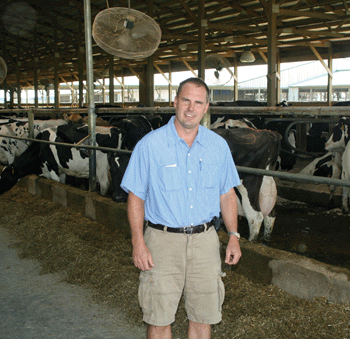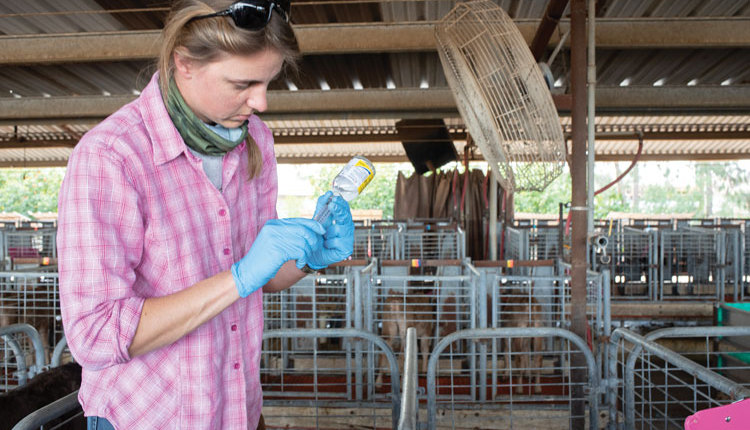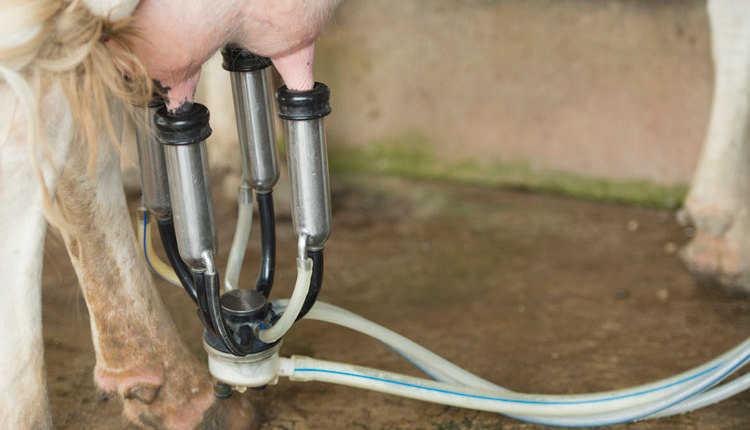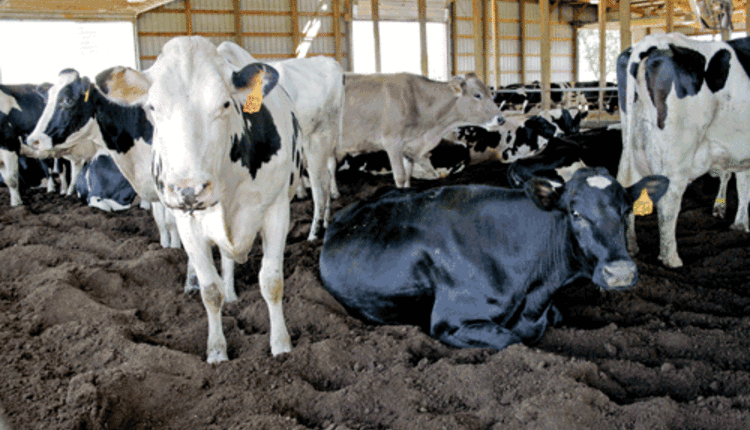Fristad and Raasch are Land O'Lakes milk production specialists based in Minnesota and South Dakota, respectively. Breiner is the milk quality manager in the cooperative's Eastern Region based in Pennsylvania.

"Our focus continues to be on clean, comfortable cows. Milk quality is a team effort starting with groomed clean stalls and alleys. A consistent milking routine and regular parlor maintenance are crucial to quality milk. Everyone on the farm participates in our SCC bonus program because each worker - no matter what the job - has an impact on milk quality."
-Nick Ridgeway, Managing Partner, United Dairies, Litchfield, Minn.
You probably are searching for ways to reduce costs, yet still maintain or even boost production. Although cost cutting seems a common sense measure, it may not be in your best financial interest, especially if it means sacrificing milk quality. Many times the costs of poor milk quality are hidden, so let's bring several to light.
It is known that, among second- and later-lactation cows with somatic cell counts greater than 200,000, each time the SCC doubles milk production drops approximately 1.5 pounds per cow per day. Less milk means a smaller milk check.
Let's use the example of two dairies with somatic cell counts of 100,000 and 400,000, respectively. Milk quality premiums can range up to 77 cents per hundredweight for an SCC of 100,000 compared to no premium for 400,000. That gives a significant advantage to operations striving for a low SCC.
Higher SCC milk lowers components such as protein and butterfat and decreases cheese yields. As SCC climbs from 100,000 to 1.3 million, cheese yields dropped by at least 2 percent. Cheeses made from milk that has high cell counts also may have a higher incidence of off-flavor products.
We've identified several of the more common profit stealers that we see fairly regularly when it comes to poor milk quality.
In these tough times, the tendency is to cut corners and stretch resources as much as possible. Cow health and quality premiums may suffer, cutting into the bottom line even more. Research has shown a significant payback on pre- and postdipping teats and using individual towels for prepping. Splitting mastitis treatment tubes and skipping tank or pipeline washes is playing with fire in both the short and long run. Having to cull one high SCC cow will pay for many gallons of teat dip and extra dry cow tubes.
Malfunctioning milking equipment can result in more udder infections and lead to costly breakdowns. Prevent problems by following a regular maintenance schedule.
Have your milking equipment dealer or other qualified person check all five basic components: the vacuum pump, vacuum controller or regulator, pulsator, teat cup shells, and teat cup liners or inflations. Other parts such as the balance tank, lines, the vacuum gauge, and the sanitary trap are accessories to these main components.
Remember, an ounce of prevention is worth a pound of cure. For example, when we're checking pulsators, it's not uncommon to find just one side working improperly. The same is true of the vacuum controller . . . fluctuating levels can go unnoticed for some time, causing milk quality issues that might have been avoided. Inflations often get twisted in the shell, causing teat end lesions.
A rejected load of milk is a waste of money and valuable resources. In many areas of the country, surplus milk and tight plant capacity add up to close scrutiny of incoming loads.
While plants have varying standards, some of the most common reasons for rejecting loads include:
• Adulterated milk, including antibiotic residue and added water.
• Milk temperature too high.
• High DMC (direct microscopic count) of bacteria.
• Sensory (smell, taste, visual)
Fluid processors often reject loads with a high PI or preincubation count. While PI counts are a very good indicator of cleaning and milking practices on the farm, recent research by Cornell and others indicates that there is no correlation between PI counts and longer shelf life of milk in stores.
Anyone who has had a load test positive for antibiotics does not have to be reminded of how expensive that is. Typically, the load is billed to the producer, but the cost does not stop there. The fee for an approved disposal site, along with the additional transportation expense, can be a considerable cost.
It is extremely important to follow the antibiotic label instructions for milk withholding times. If in doubt, check a milk sample with an approved antibiotic test before shipping milk. Any extra-label use of antibiotics should be clearly marked with withdrawal times by your veterinarian.
Failing an inspection is another hidden cost of poor-quality milk. Failing an Interstate Milk Shippers survey stops all milk in that area from going to a bottling plant. That milk must then be transported to a manufacturing plant, while the bottling plant scrambles for additional milk.
The plant's field staff is diverted from other duties to help producers correct any violations so that they pass a resurvey. The producer typically must pay the reinspection fee and may get a downgraded milk price. Make sure all family members and employees keep your operation inspection ready, as most are unannounced. Explain the importance of shutting doors, keeping jetter cups in the holders, proper use and storage of fresh cow pails, cleanliness of tank interiors, and proper drug storage. Passing all inspections means that milk can continue flowing to normal markets and without extra costs.
Today, dairy product sales are global and, therefore, are subject to import standards. The European Union, New Zealand, Australia, and a few other countries have adopted a maximum SCC standard for Grade A milk of 400,000. Canada's SCC limit is 500,000, while the U.S. has a legal maximum of 750,000. Lower SCC standards often are proposed and discussed which would make it difficult for U.S. producers to compete unless that standard is met.
Finally, here are a few other ways to cut costs without sacrificing milk quality:

"Our focus continues to be on clean, comfortable cows. Milk quality is a team effort starting with groomed clean stalls and alleys. A consistent milking routine and regular parlor maintenance are crucial to quality milk. Everyone on the farm participates in our SCC bonus program because each worker - no matter what the job - has an impact on milk quality."
-Nick Ridgeway, Managing Partner, United Dairies, Litchfield, Minn.
You probably are searching for ways to reduce costs, yet still maintain or even boost production. Although cost cutting seems a common sense measure, it may not be in your best financial interest, especially if it means sacrificing milk quality. Many times the costs of poor milk quality are hidden, so let's bring several to light.
It is known that, among second- and later-lactation cows with somatic cell counts greater than 200,000, each time the SCC doubles milk production drops approximately 1.5 pounds per cow per day. Less milk means a smaller milk check.
Let's use the example of two dairies with somatic cell counts of 100,000 and 400,000, respectively. Milk quality premiums can range up to 77 cents per hundredweight for an SCC of 100,000 compared to no premium for 400,000. That gives a significant advantage to operations striving for a low SCC.
Higher SCC milk lowers components such as protein and butterfat and decreases cheese yields. As SCC climbs from 100,000 to 1.3 million, cheese yields dropped by at least 2 percent. Cheeses made from milk that has high cell counts also may have a higher incidence of off-flavor products.
We've identified several of the more common profit stealers that we see fairly regularly when it comes to poor milk quality.
In these tough times, the tendency is to cut corners and stretch resources as much as possible. Cow health and quality premiums may suffer, cutting into the bottom line even more. Research has shown a significant payback on pre- and postdipping teats and using individual towels for prepping. Splitting mastitis treatment tubes and skipping tank or pipeline washes is playing with fire in both the short and long run. Having to cull one high SCC cow will pay for many gallons of teat dip and extra dry cow tubes.
Malfunctioning milking equipment can result in more udder infections and lead to costly breakdowns. Prevent problems by following a regular maintenance schedule.
Have your milking equipment dealer or other qualified person check all five basic components: the vacuum pump, vacuum controller or regulator, pulsator, teat cup shells, and teat cup liners or inflations. Other parts such as the balance tank, lines, the vacuum gauge, and the sanitary trap are accessories to these main components.
Remember, an ounce of prevention is worth a pound of cure. For example, when we're checking pulsators, it's not uncommon to find just one side working improperly. The same is true of the vacuum controller . . . fluctuating levels can go unnoticed for some time, causing milk quality issues that might have been avoided. Inflations often get twisted in the shell, causing teat end lesions.
A rejected load of milk is a waste of money and valuable resources. In many areas of the country, surplus milk and tight plant capacity add up to close scrutiny of incoming loads.
While plants have varying standards, some of the most common reasons for rejecting loads include:
• Adulterated milk, including antibiotic residue and added water.
• Milk temperature too high.
• High DMC (direct microscopic count) of bacteria.
• Sensory (smell, taste, visual)
Fluid processors often reject loads with a high PI or preincubation count. While PI counts are a very good indicator of cleaning and milking practices on the farm, recent research by Cornell and others indicates that there is no correlation between PI counts and longer shelf life of milk in stores.
Anyone who has had a load test positive for antibiotics does not have to be reminded of how expensive that is. Typically, the load is billed to the producer, but the cost does not stop there. The fee for an approved disposal site, along with the additional transportation expense, can be a considerable cost.
It is extremely important to follow the antibiotic label instructions for milk withholding times. If in doubt, check a milk sample with an approved antibiotic test before shipping milk. Any extra-label use of antibiotics should be clearly marked with withdrawal times by your veterinarian.
Failing an inspection is another hidden cost of poor-quality milk. Failing an Interstate Milk Shippers survey stops all milk in that area from going to a bottling plant. That milk must then be transported to a manufacturing plant, while the bottling plant scrambles for additional milk.
The plant's field staff is diverted from other duties to help producers correct any violations so that they pass a resurvey. The producer typically must pay the reinspection fee and may get a downgraded milk price. Make sure all family members and employees keep your operation inspection ready, as most are unannounced. Explain the importance of shutting doors, keeping jetter cups in the holders, proper use and storage of fresh cow pails, cleanliness of tank interiors, and proper drug storage. Passing all inspections means that milk can continue flowing to normal markets and without extra costs.
Today, dairy product sales are global and, therefore, are subject to import standards. The European Union, New Zealand, Australia, and a few other countries have adopted a maximum SCC standard for Grade A milk of 400,000. Canada's SCC limit is 500,000, while the U.S. has a legal maximum of 750,000. Lower SCC standards often are proposed and discussed which would make it difficult for U.S. producers to compete unless that standard is met.
Finally, here are a few other ways to cut costs without sacrificing milk quality:
- Clean compressors to reduce energy costs. They should be inspected and cleaned monthly, especially during warm weather. We use a specific tool, called a "fin comb," to straighten any flat fins out.
- Cut the clutter; clean up. A clean, organized facility and environment improve labor productivity and attitudes.








